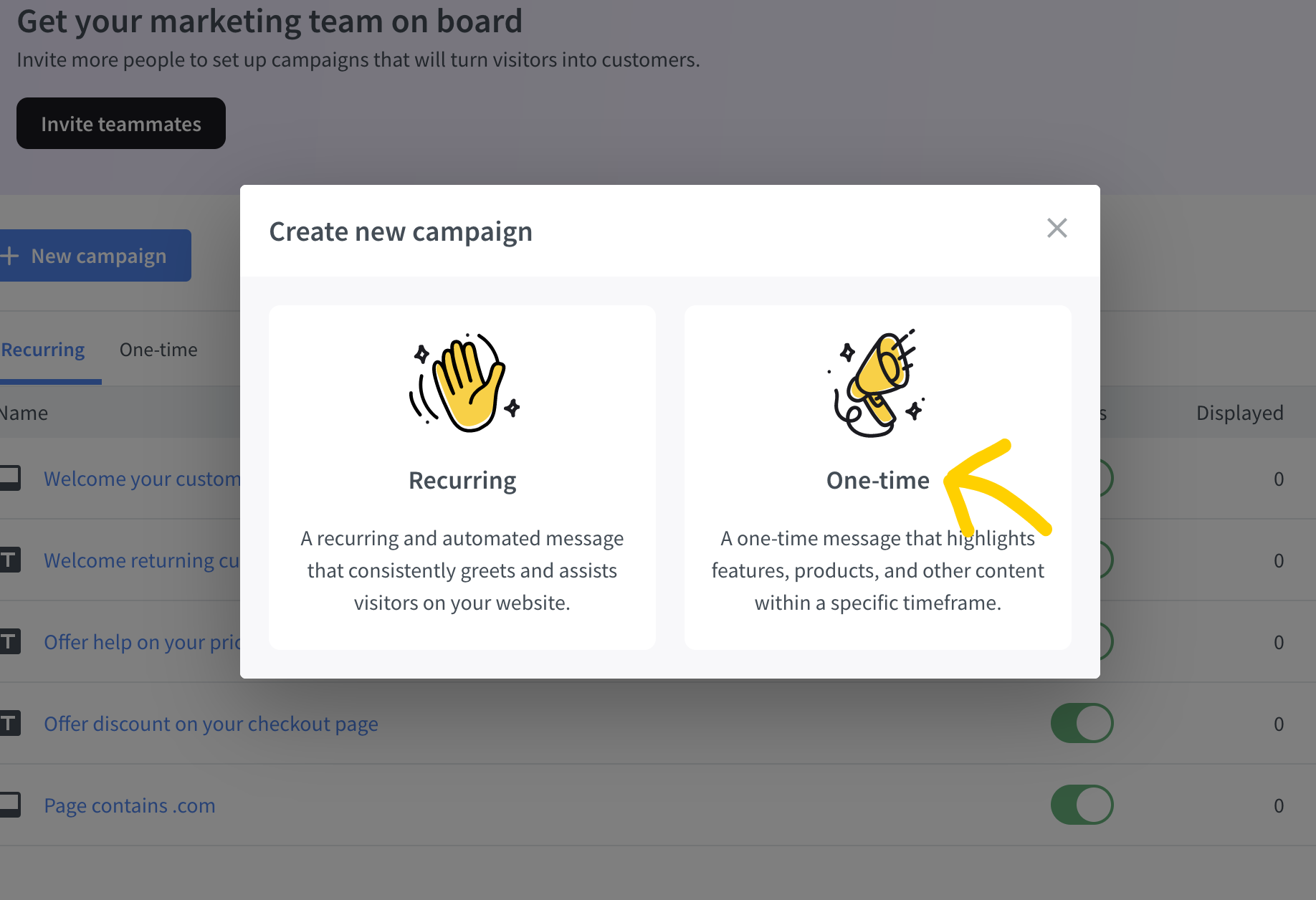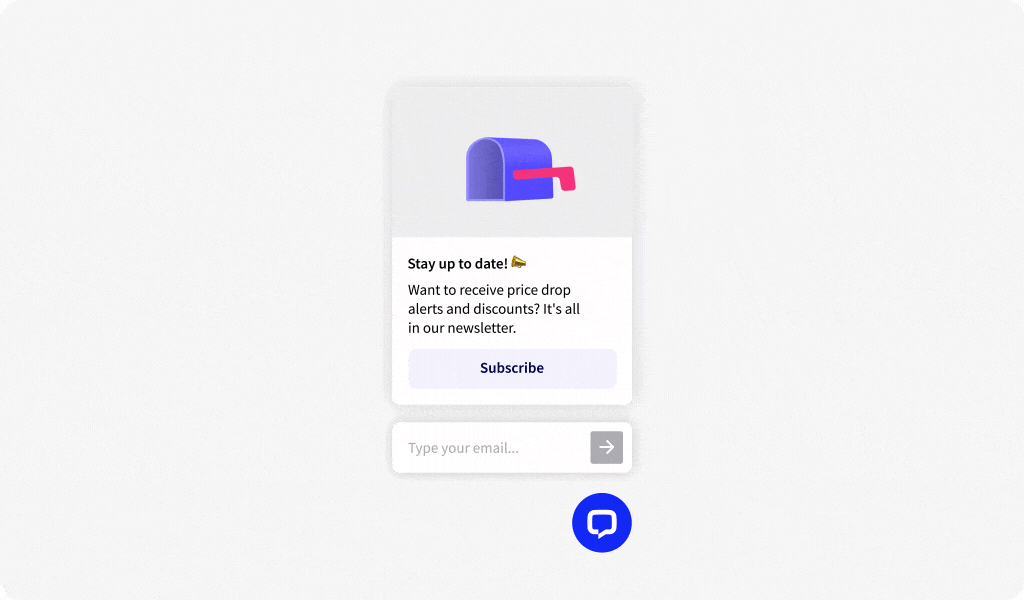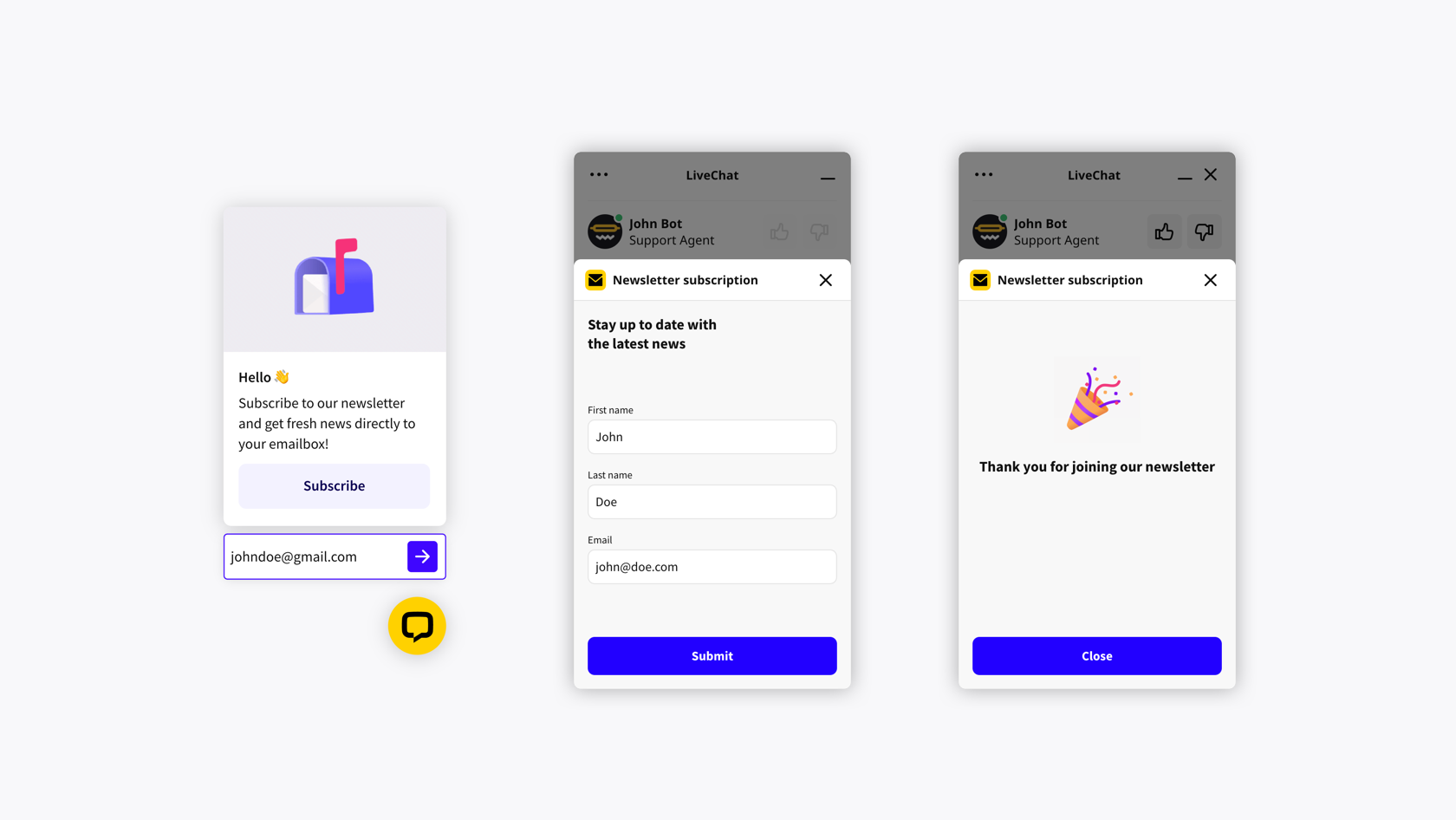One time campaigns are a customer engagement feature that can help you create urgency. They are displayed to each customer once per lifetime, so the customer can either jump on the opportunity they announce then and there, or they can start a chat to find out more. It really is a win-win situation!
One-time campaigns can be used to announce flash sales, introduce new releases, invite customers to events, communicate business interruptions, and much more.
Sales and marketing
One-time campaigns are a great tool for letting your customers know about limited-time offers. You can offer a discount to only a segment of your audience, e.g., only the returning visitors or ones coming from social media campaigns. Use the campaign conditions to target these specific visitors.
To set up a one-time campaign like the one above, go to Engage> Campaigns in your LiveChat agent app and select “New campaign”

In the pop-up, choose “One-time”.

The next step is exactly the same as with recurring campaigns. First, you choose the look of the campaign. You can choose from Card, Quick replies, or Plain text. To set up a campaign exactly like the one in our example, pick the card type, add your image, and add an “Open URL” button with a link to your Christmas deals page. Once you’re ready, click on “Next: set conditions.”
With one-time campaigns, you can decide on the time frame for when the campaign should be displayed to your customers. Each one-time campaign will only be displayed once for every visitor and only in the time frame you set up. That can be seven days, 30 days, or a custom period. Select the appropriate time from the drop-down menu.
Next, set the conditions. Which segments of your website audience should see your one-time campaign? If you are running a marketing campaign on social media, you can set the condition for the referring website address to only display the campaign to visitors coming from this initiative. You can read more about setting up conditions here. You can also choose to only display the one-time campaign to first-time or returning visitors. If you would like the visitors to spend a certain amount of time on your website before they see the campaign, set up a time delay.
You can take advantage of the Google Analytics integration to find the best time to display a campaign.
Once you have set up the conditions, click on “Save campaign.” And that’s it. Your one-time campaigns is now live.
What if you have introduced a new feature in your SaaS product? Once again, one-time campaigns are the perfect way to let your customers know about that. The one-time campaign is only shown once, so you can whet their interest without pushing the feature on them. If they feel like they missed out, they can always start a chat, right?
The one-time campaign in our example is once again a Card type with Open URL buttons for the sign-up page and the page dedicated to the new release. For the conditions, you can decide to only announce the feature on a specific page using the “Current page URL” condition and only to logged-in users with the “Custom variables” condition.
Customer communication
Use one-time campaigns to invite your customers to events or to keep them informed about business interruptions.
To create a one-time campaign like the one above, pick the card type, add your image, edit the text, and add an “Open URL” button linking to the signup page for the event you are advertising.
For conditions, decide how long the one-time campaign should be displayed (seven days, 30 days, or a custom period) and to which segment of your audience. For example, use “All visitors” condition to show it to both the first and returning visitors. To show it only on a specific page connected with the event, use “Current page URL” condition. If you would like only the logged-in users to see it, use the “Custom variables” condition.
One-time campaigns can also be used to let your customers know about a business interruption.
Let’s say you are planning a break in the service you provide. With one-time campaigns, you can keep your customers informed and give them an opportunity to get in touch with you anyway. To set up a one-time campaign like the one above, pick the “Quick replies” type and then edit the text and replies. Next, set conditions like, for example, customer’s browsing time and the current page URL. This way, the campaign will be displayed to the customers looking for information about your availability.
Growing lead base
If you use Mailchimp, you can let your customers subscribe to your newsletter right from the one-time campaign. The Mailchimp integration campaign opens a subscription form right in the chat widget when the customer clicks on the Subscribe button.

In the LiveChat agent app, you define which audience the lead should be added to. So, once the customer clicks Submit, their email is added to the designated Mailchimp audience. See the <a href=“https://www.livechat.com/help/gain-new-subscribers-using-mailchimp-integration/#use-automatic-subscription-invites"_blank">**Mailchimp integration manual** for step by step by step instructions.

Once you have installed the Mailchimp integration, all that is left to do is edit your campaign. You can pick from the available templates or link to a custom image. The template comes with a preset Subscribe button that opens the subscription form. Once the look of the campaign is set, click on Next: set conditions. Set up the date when the campaign should be displayed, and which segment of your audience should the it target: first time or returning visitors, visitors coming from specific campaigns, visitors in specific countries, etc. This way you know exactly which customers you target, and their experience of signing up for your newsletter is virtually seamless.
Additional tips
Campaigns are available in the Team, Business, and Enterprise plans. You can have up to ten campaigns at a time, so make sure to delete the ones you no longer need.
- Right now, a one-time campaign runs from the moment of creation until the specified date in the configuration. We are working on the option to set a custom starting date.
- Campaigns are displayed to the visitors who match the conditions set for them. Once you set up your campaign, make sure that its conditions don’t overlap with those of another campaign in a way that can distract the visitor from your desired action.
- A one-time campaign is only delivered once for each customer, so the same user will not see it again.
- Enable “Multiple campaigns” to make sure your customers will see the one-time and the recurring campaigns you set.
- To test newly created campaign, open your website using the incognito/private mode in your browser For Mac, press Command + Shift + N or P, depending on the browser. For Windows, press Control + Shift + N or P, depending on the browser.
- If you are using Groups (see this article for more information), always make sure that you are editing the campaigns for the correct group. Groups can be picked from the drop-down menu in Settings> Engage>Campaigns.
- On mobile devices, campaigns are always displayed as a bubble
- If you want the campaign to be triggered when all conditions are met, choose “Match all of these conditions.” If you want it to be triggered when at least one of the conditions is met choose “Match one of these conditions.”

